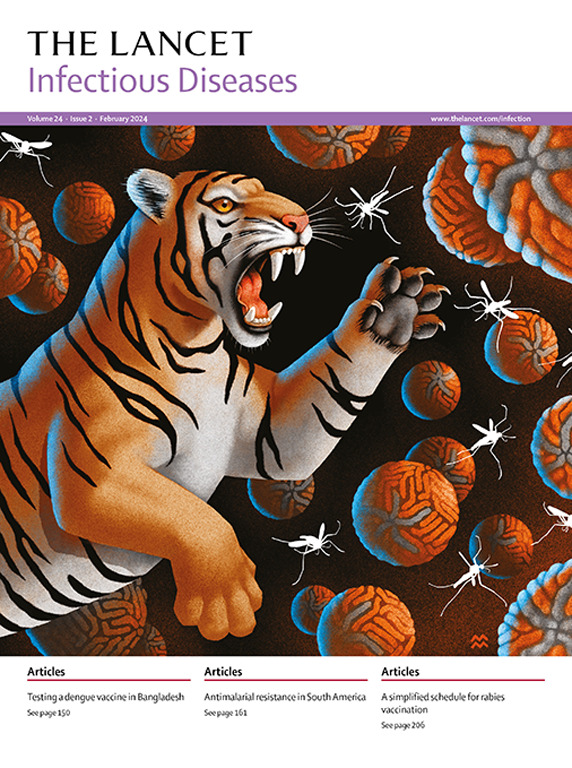The effect of Plasmodium falciparum exposure and maternal anti-circumsporozoite protein antibodies on responses to RTS,S/AS01E vaccination in infants and children: an ancillary observational immunological study to a phase 3, randomised clinical trial
IF 31
1区 医学
Q1 INFECTIOUS DISEASES
引用次数: 0
Abstract
Background
The RTS,S/AS01E malaria vaccine showed lower antibody response and protective efficacy in infants aged 6–12 weeks compared with children aged 5–17 months (for whom this vaccine is recommended). We aimed to study the effect of previous Plasmodium falciparum exposure on the antibody responses to RTS,S/AS01E vaccination in infants and children, and the mediating effect of baseline (including maternal) anti-circumsporozoite protein (CSP) antibodies.Methods
In this observational study, we included children and infants from six African countries (Burkina Faso, Gabon, Ghana, Kenya, Mozambique, and Tanzania) enrolled in the MAL067 immunology ancillary study of the RTS,S/AS01E phase 3 clinical trial from March 27, 2009, to Jan 21, 2011. We used comparator-vaccinated infants and children to identify antibody-based signatures of previous P falciparum exposure, which were later applied to RTS,S/AS01E-vaccinated infants and children. In these participants, we explored the relationship between vaccine antibody immunoglobulin G (IgG) responses measured by ELISA and pre-vaccination serological markers of malaria exposure by assessing the IgG levels against 1000 P falciparum antigens using partial proteome microarrays.Findings
We included 718 comparator-vaccinated infants (348 [48%]) and children (370 [52%]) and 606 RTS,S/AS01E-vaccinated infants (329 [54%]) and children (277 [46%]). Anti-CSP IgG responses to primary vaccination did not correlate with a baseline signature of previous exposure in children, suggesting that prior P falciparum exposure does not significantly affect antibody immunogenicity in children (Pearson's r=–0·02 [95% CI –0·13 to 0·10]). By contrast, high P falciparum exposure signature levels at the time of vaccination in infants, presumably driven by maternally transferred antibodies and declining within the initial 6–12 months of life, correlated with reduced RTS,S/AS01E responses (r=–0·17 [–0·27 to –0·06]). This negative correlation was stronger for anti-CSP IgG than for the exposure signature or any other more immunogenic blood stage P falciparum antigens (r=–0·42 [–0·50 to –0·33]), persisted after adjustment by baseline levels of the exposure signature (semi-partial correlation r=–0·44 [–0·55 to –0·33]), and involved antibodies to the central NANP region (r=–0·39 [–0·49 to –0·28]) but not the C-terminal region (r=0·02 [–0·10 to 0·15]) of CSP. The negative effect of maternal anti-CSP IgG in infants did not appear to be confounded by other malaria transmission-dependent variables.Interpretation
Interference between passive immunity and vaccine response is clinically significant and might affect the implementation of next-generation CSP-based vaccines for young infants and mothers as well as passive immunisation with human monoclonal antibodies.Funding
US National Institutes of Health, National Institute of Allergy and Infectious Diseases; PATH–Malaria Vaccine Initiative; Spanish Ministerio de Economía y Competitividad (Instituto de Salud Carlos III), European Regional Development Fund and European Social Fund; Fundación Ramón Areces; Spanish Ministry of Science and Innovation; and Generalitat de Catalunya (CERCA Program).恶性疟原虫暴露和母体抗圆孢子虫蛋白抗体对婴幼儿接种 RTS,S/AS01E 疫苗反应的影响:3 期随机临床试验的辅助观察免疫学研究
背景RTS,S/AS01E疟疾疫苗在6-12周大婴儿中的抗体反应和保护效力低于5-17个月大(推荐接种该疫苗)的儿童。我们的目的是研究既往恶性疟原虫暴露对婴幼儿接种 RTS,S/AS01E 疫苗后抗体反应的影响,以及基线(包括母体)抗圆孢子虫蛋白 (CSP) 抗体的中介作用。方法在这项观察性研究中,我们纳入了 2009 年 3 月 27 日至 2011 年 1 月 21 日期间参加 RTS,S/AS01E 3 期临床试验 MAL067 免疫学辅助研究的六个非洲国家(布基纳法索、加蓬、加纳、肯尼亚、莫桑比克和坦桑尼亚)的儿童和婴儿。我们利用接种过对比疫苗的婴儿和儿童来确定先前恶性疟原虫暴露的抗体特征,随后将其应用于接种过 RTS,S/AS01E 疫苗的婴儿和儿童。在这些参与者中,我们使用部分蛋白质组芯片评估了针对 1000 种恶性疟原虫抗原的 IgG 水平,从而探讨了通过 ELISA 测量的疫苗抗体免疫球蛋白 G (IgG) 反应与接种前疟疾暴露血清学标记物之间的关系。研究结果我们纳入了 718 名接种过对比疫苗的婴儿(348 [48%])和儿童(370 [52%]),以及 606 名接种过 RTS,S/AS01E 疫苗的婴儿(329 [54%])和儿童(277 [46%])。儿童对初次接种的抗 CSP IgG 反应与先前暴露的基线特征无关,这表明先前的恶性疟原虫暴露不会显著影响儿童的抗体免疫原性(Pearson's r=-0-02 [95% CI -0-13 to 0-10])。相比之下,婴儿接种疫苗时的恶性疟原虫暴露特征水平较高,可能是受母体转移抗体的影响,并在出生后的最初 6-12 个月内下降,这与 RTS,S/AS01E 反应的降低有关(r=-0-17 [-0-27 to -0-06])。抗 CSP IgG 的这种负相关性比暴露特征或任何其他免疫原性更强的血期恶性疟原虫抗原更强(r=-0-42 [-0-50 to -0-33])、在根据暴露特征的基线水平进行调整后,抗 CSP IgG 的负作用仍然存在(半相关性 r=-0-44 [-0-55 to -0-33]),并且涉及 CSP 的 NANP 中心区抗体(r=-0-39 [-0-49 to -0-28])而非 C 端区抗体(r=0-02 [-0-10 to 0-15])。解释被动免疫和疫苗反应之间的干扰具有重要的临床意义,可能会影响为婴儿和母亲接种基于CSP的下一代疫苗以及使用人类单克隆抗体进行被动免疫。资金来源美国国立卫生研究院、国立过敏与传染病研究所、PATH-疟疾疫苗计划、西班牙经济与竞争部(卡洛斯三世健康研究所)、欧洲区域发展基金和欧洲社会基金、拉蒙-阿雷斯基金会、西班牙科学与创新部和加泰罗尼亚自治区(CERCA 计划)。
本文章由计算机程序翻译,如有差异,请以英文原文为准。
求助全文
约1分钟内获得全文
求助全文
来源期刊

Lancet Infectious Diseases
医学-传染病学
CiteScore
60.90
自引率
0.70%
发文量
1064
审稿时长
6-12 weeks
期刊介绍:
The Lancet Infectious Diseases was launched in August, 2001, and is a lively monthly journal of original research, review, opinion, and news covering international issues relevant to clinical infectious diseases specialists worldwide.The infectious diseases journal aims to be a world-leading publication, featuring original research that advocates change or sheds light on clinical practices related to infectious diseases. The journal prioritizes articles with the potential to impact clinical practice or influence perspectives. Content covers a wide range of topics, including anti-infective therapy and immunization, bacterial, viral, fungal, and parasitic infections, emerging infectious diseases, HIV/AIDS, malaria, tuberculosis, mycobacterial infections, infection control, infectious diseases epidemiology, neglected tropical diseases, and travel medicine. Informative reviews on any subject linked to infectious diseases and human health are also welcomed.
 求助内容:
求助内容: 应助结果提醒方式:
应助结果提醒方式:


